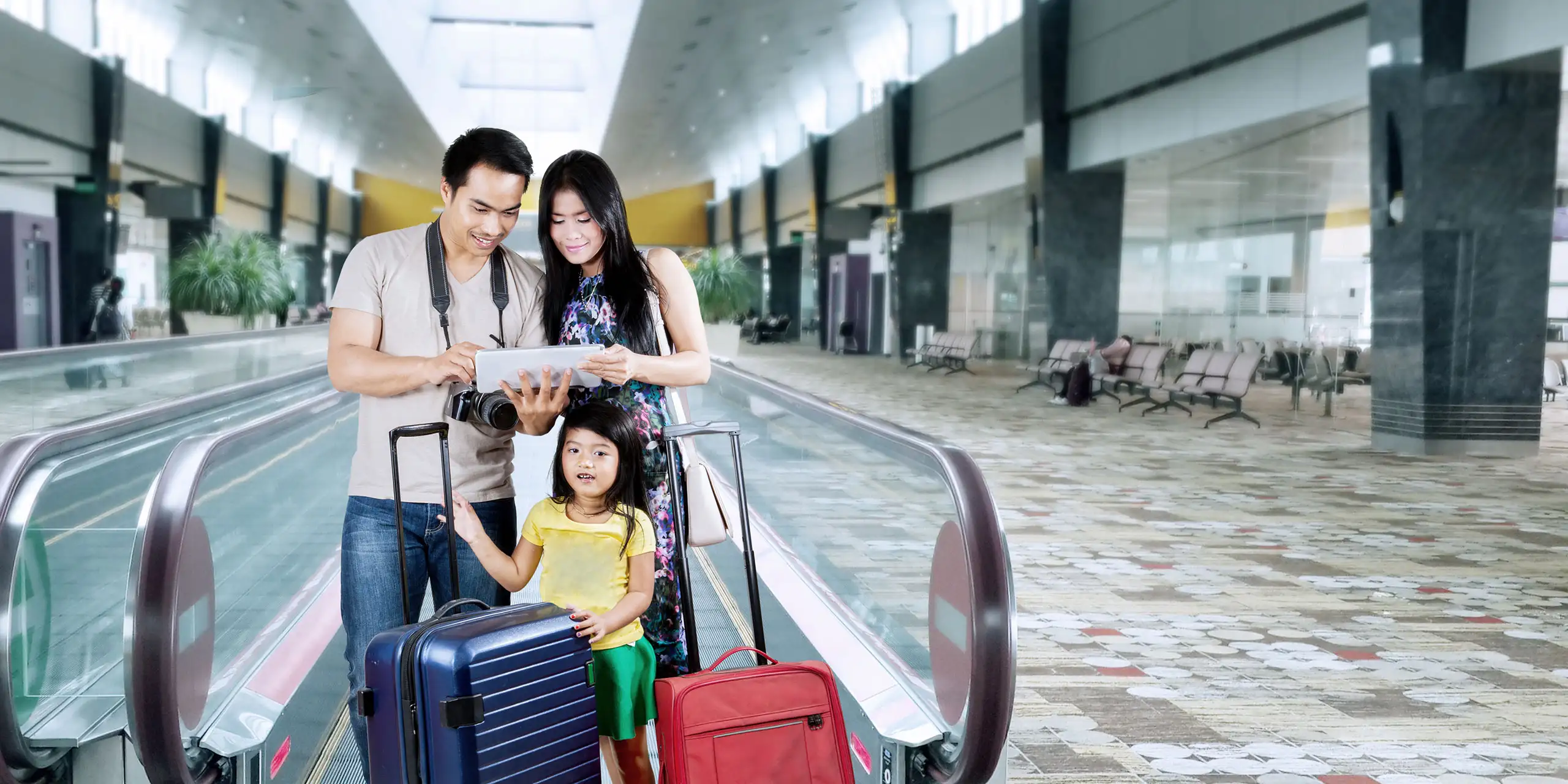Ask many parents for their best tips for international travel with kids and they’ll be quick to the point with a resounding, “Don’t do it.” But that’s not how we think, of course.
Traveling through time zones and changing currencies and languages with little kids in tow hardly has to be a headache when you approach it with the right knowledge and preparation. Of course, we’re not promising the joy’s going to be in the journey. But we do have plenty of advice on how to ease your travels and be ready to enjoy your destination to the fullest when you arrive. And remember, the earlier you get your little ones used to jetsetting, the better little world travelers they’re going to become!
International Travel With Kids: Documentation
Before you book your tickets, check the expiration dates of everybody’s passport to make sure they extend to at least three months after you return from your trip. Not all countries require this expiry window, but many do. If a passport expires before the three-month period, call your destination’s embassy to inquire about their particular rules; don’t rely on the airlines to know the rules.
Next, make two copies of all passport photo pages before you leave home. Bring one set of copies with you and leave the others with a friend or relative as backup.
Finally, before you get to the airport, designate one family member with carrying all of your passports everywhere you go; it will be easiest to present them together as a group. One of those plastic folders that closes and will fit neatly into a laptop case or backpack is great for keeping all of your documents together.
International Travel With Kids: Consent Letters
Surprisingly, neither airlines in the U.S. nor the TSA have a hard and fast rule when it comes to what sort of consent documents a parent needs to travel domestically or internationally with a child. In fact, children under 18 don’t need to have identification to go through security and travel domestically (they do need a passport if traveling internationally, of course). If your child looks older than 18, however, there’s a chance they’ll be questioned, so it’s a good idea to have them travel with a copy of their birth certificate, school ID or driver’s license. What all of this means is that aunts and uncles, grandparents—even friends—can board a flight with a child without showing any sort of letter of consent.
Where you might run into trouble, however, is in your arrival country, where you may be asked by immigration to prove your relationship to the child. Again, rules will vary by country, so contact the embassy for specific information in advance of your travels. Either way, it’s always a good idea to have a notarized note of permission from your child’s other parent if they’re not traveling with you, as well as a letter from a child’s parents if you’re traveling with a niece, nephew, friend’s child, etc. Visit a local notary or better yet, get your document notarized on a site like Notarize.com, which offers the ability to notarize a document in about 15 minutes.
International Travel With Kids: Child Airfare
Child airfare on most international flights is free for kids under age 2, but you’ll be required to pay taxes for the same lap seat for kids under 2, and depending on your destination, that can add up to hundreds of dollars. Weigh the price of buying an additional seat with the length of your flight and the idea of having your kid on your lap for a long time, then decide what works best for you.
Also keep in mind that most airlines require babies be at least 14 days old for their first flight, and you’re only allowed one lap baby per adult. And while U.S. airlines do not offer child fares (read: discounts) for kids over 2, a few international carriers still do—either in the form of special deals, or discounts on miles needed for award travel—so it’s worth asking when you book. Both U.S. and international airlines will occasionally offer kids fly free incentives, too.
International Travel With Kids: 8 Tips
1. Weigh your destination. An international family vacation is likely to involve a rather serious outlay of cash in airfare and passport and visa fees alone. Look for places that bring to the table a balance of offerings—urban and nature, relaxation and organized activities—so you can keep your vacation interesting to everyone. Also, don’t be afraid of a long journey if the destination is one that can save you lots of money. Bali might require a few flights, for example, but once you’re there and spa treatments are $10 an hour and babysitting just a fraction of that, you’ll be glad you came.
2. Buy a good travel stroller. While cheap umbrella strollers will surely give you some trouble on the cobbled streets in Europe or jungle trails in Costa Rica, they’re more likely to be a life saver at some point (and are far easier to transport than that comfort cruiser you use back home). Once you get to the airport, if your layovers aren’t too long, plan to check the stroller and just carry your baby around the terminal in the carrier, taking turns with your partner if possible. As for car seats, most rental car companies can provide them at your destination, but you’ll want to verify that in advance.
Related: 10 Best Umbrella Strollers for Travel
3. Choose non-stop flights or long layovers. Nonstop flights are always best when traveling internationally with a family. But if they’re not an option due to price or routing, make sure you have at least 1.5 hours for your layover, since getting around the airport as a family takes longer than on your own. And if your flight involves two flights of more than six hours with a stop in between (New York to Los Angeles to Hong Kong, for example), you should consider spending the night after the first leg instead of opting for a long layover. It’ll make the travels easier on everyone.
4. Prepare for delayed luggage. Since everyone in your party is entitled to a carry-on bag, get all of your older kids to wear backpacks with at least one change of clothes inside, as well as any of those sleeping aids and favorite snacks they can’t live without. If you need both of your hands to carry an infant or push a stroller, pack an extra change of clothes for yourself, too, in one of your kids’ bags. And if you’re alone and traveling with a small child, bring at least one carry-on between you. Be sure to keep all of your checked baggage tags together with your passports, too, as you’ll need to show those to report a bag that didn’t arrive on time.
Related: How to Prevent and Survive Lost Luggage
5. Have a plan for jet lag. There’s no avoiding it, jet lag happens. And no matter how much sleep you all manage to get on the plane (it’s possible, right?), at some point the time difference is going to affect everyone. Taking a quick siesta at the hotel on arrival may seem like a good idea, but it’s more likely to throw everyone out of wack. The best course of action is to plan to stay up until at least 7 or 8 p.m. local time on the day of your arrival. And you may be surprised to find that even the time change doesn’t keep your kids from being little Energizer bunnies, with all the excitement of visiting someplace new.
Related: 12 Tips for Managing Jet Lag With Kids
6. Pack less. Instead of bringing tons of toys along, opt for just a favorite one or two. And while you might have your favorite baby food, wipes and diapers back home, most every country has stores that stock similar stuff—so pack what you need for the travels and the first day or two, and plan to stock up on the rest once you arrive. Similarly, don’t think about bringing your own portable baby bed. Most hotels can offer them free of charge, and that’s another thing you can check on in advance with a quick phone call or hotel reviews. Also, if you have friends or family in your destination, ask for help rounding up things that take up a lot of space—winter clothes, bedding, and the like—that you can borrow during your stay.
Related: Interactive Family Packing List
7. Splurge on transportation. Getting around by public transport to experience the local life may have very well been your jam during your backpacker days. But it’s always worth splurging on something more comfortable and time-efficient when you’re traveling as a family, so don’t think twice and grab that more expensive taxi instead. Keep in mind, too, that while trains may be more expensive than the bus, they also offer more room for kids to move around. Cutting costs on logistics is always a good thing—the more you have to spend on activities!—but for every decision you make as a family, weigh the benefits of things that may cost a bit extra, but save you serious stress, too.
8. Realize you can’t do it all. Having realistic exceptions of a family trip abroad goes a long way in making it a success. If you’re visiting multiple places, plan to spend at least three nights in each destination during your vacation to give kids time to relax. It’s worth spending a little more on a hotel closer to town and the attractions that you’ve come to see, too, so you spend less time moving between points A and B.
Longtime travel writer and adventurer Terry Ward lives in Florida with her husband and young son and daughter. She’s constantly on the lookout for the next Scandinavia Airlines Kids Fly Free deal to save money on flights to Norway, her favorite place to visit both in the winter (Northern Lights!) and summer (Midnight Sun!). A travel writer since 2001 (read: long before the kids came along), she’s written for such publications as Endless Vacation Magazine, Conde Nast Traveler and Scuba Diving Magazine, among many others. Find Terry on her website, Terry-Ward.com.
Our team of parents and travel experts chooses each product and service we recommend. Anything you purchase through links on our site may earn us a commission.







